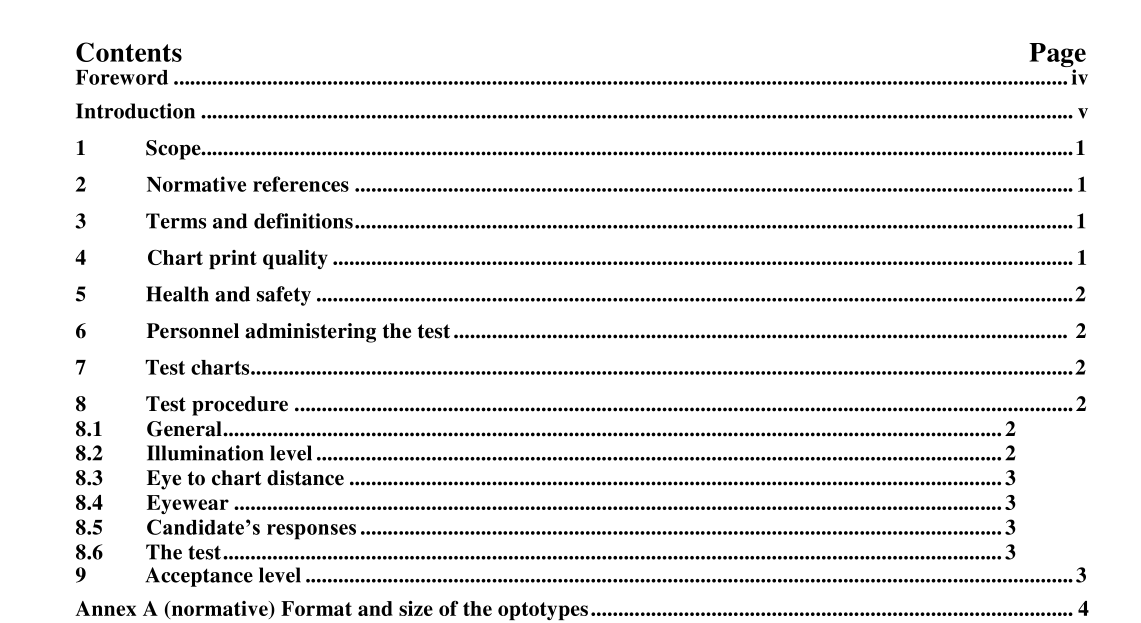ISO 18490:2015 pdf download.Non-destructive testing — Evaluation of vision acuity of NDT personnel
1 Scope
This International Standard specifies the form of the optotype, the quality requirements for the chart, the test procedure, and the acceptance level for near vision acuity of NDT personnel. It also addresses the qualification requirements for personnel permitted to carry out the test. This International Standard only addresses near vision acuity under defined conditions similar to those encountered during routine NDT inspection. It does not address an individual’s overall visual acuity and users are advised to consider the need for a general eye examination by specialist medical personnel to ensure general vision acuity is appropriate for job function. This International Standard does not address colour vision requirements.
2 Normative references
The following documents, in whole or in part, are normatively referenced in this document and are indispensable for its application. For dated references, only the edition cited applies. For undated references,the latest edition of the referenced document (including any amendments) applies.
ISO 9712, Non-destructive testing — Qualification and certification of NDT personnel
EN 4179 ^Aerospace series — Qualification and approval of personnel for non-destructive testing
3 Terms and definitions
For the purposes of this document, the terms and definitions given in ISO 9712 and EN 4179 and the following apply.
3.1 optotype
E shaped character of defined proportions and of various sizes that are used to verify near vision acuity
3.2 eyewear
any form of lens or protective transparent material placed or used between the human eye and the work piece during routine NDT inspection operations
4 Chart print quality
It is recognized that charts produced locally will have varying print quality and resolution. The chart design,including the two separate blocks of characters, and the procedure has been developed to ensure that meeting the defined level will demonstrate compliance. Failure to meet the defined level of acuity, in some cases, may be due to the quality of the test chart produced. Care should be exercised to ensure that the quality of the test chart is appropriate and where personnel fail to meet the required level, the quality of the chart should be reviewed before declaring that an individual has inadequate near vision.
7 Test charts
Test charts shall be prepared in accordance with this International Standard. Charts shall be printed in black ink on white paper of an adequate quality and using equipment that ensures the print quality is suitable for the purpose. Charts shall be printed in black ink on white paper using equipment that ensures the print quality is suitable for the purpose. The printing equipment and the paper used shall be of an adequate quality for the purpose. This shall be verified practically by using magnification. The two blocks of optotypes (see Annex A) have been developed to accommodate the different types of printing equipment commonly encountered. The block which prints best shall be used. This can be determined under good lighting conditions using approximately 10x magnification. Inspect lines 9 and 10 and verify that the lines forming the limbs of the E characters on line 9 are all continuous and of an even appearance. There shall not be any spread of the print material such that the gaps between the limbs are not visible. Line 10 characters may not all be perfectly formed due to the very small size and since it is not necessary to distinguish this line for compliance, the quality of this line does not form part of the acceptance criteria for the chart. It is, however, required that the overall shape of each optotype shall be discernible under magnification with the limbs and gaps being evident.
ISO 18490:2015 pdf download
